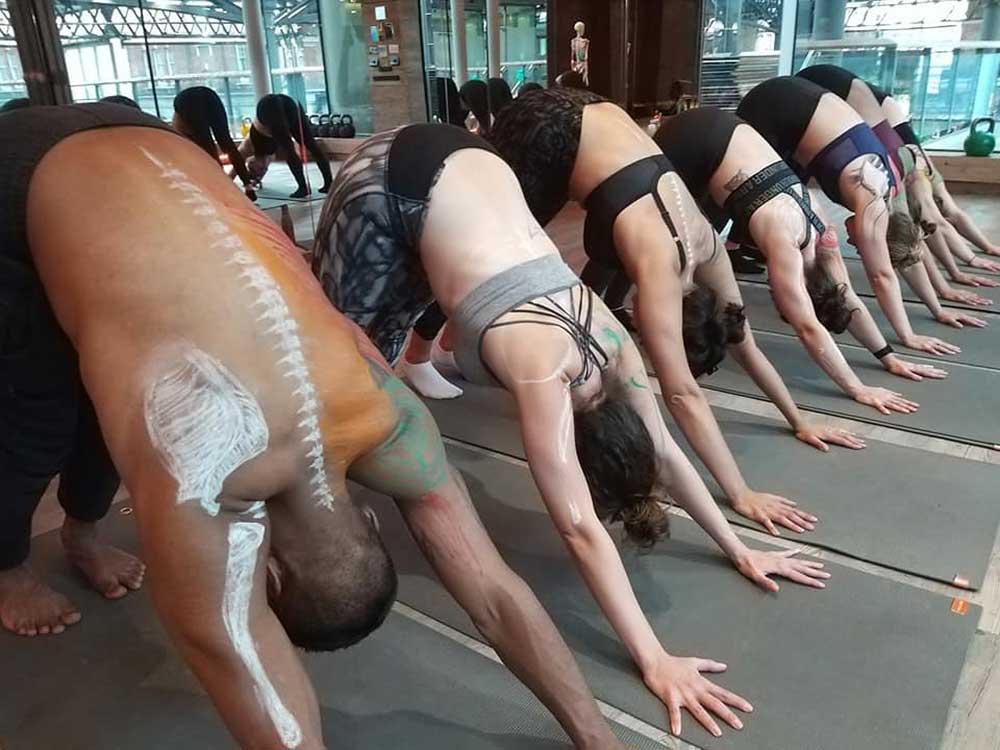
CPD : Embodied & experimental movement anatomy
- Easter weekend 4-day course – 10th, 11th, 12th & 13th April 2020 included
- Venue: Pilates Manchester, 5 Wharf Road, Sale, M33 2AF
- Time:: 10- 5pm Fri, Sat, Sun & Mon (24 hours lessons plus one hour lunch each day)
- CPD : 24 hours
- Pre-requisite Reading: “Fascia, Anatomy & Movement” – Jo Avison, “Bowen Unravelled” – Julian Baker
- Cancellation Policy: See Here
- Bed & Breakfast: See Here
Cost : £425 early bird including manual
Pilates Anatomy for enthusiasts & teacher training programmes
 Delivering anatomy in teacher training can be challenging, especially with the latest updates in fascia and movement. Nisha provides anatomy instruction that not only helps students pass exams but keeps the subject engaging and applicable. The content is delivered creatively through art, exploration, and kinaesthetic learning. Unlike standard courses, it uses cadaveric research, focusing on the integrated system and the subtle body, incorporating life coaching, body therapy, and somatic arts. The 24-hour course spans two weekends and includes a comprehensive manual. Known as ‘The Radical Anatomist,’ Nisha offers a unique approach, with advanced modules available online.
Delivering anatomy in teacher training can be challenging, especially with the latest updates in fascia and movement. Nisha provides anatomy instruction that not only helps students pass exams but keeps the subject engaging and applicable. The content is delivered creatively through art, exploration, and kinaesthetic learning. Unlike standard courses, it uses cadaveric research, focusing on the integrated system and the subtle body, incorporating life coaching, body therapy, and somatic arts. The 24-hour course spans two weekends and includes a comprehensive manual. Known as ‘The Radical Anatomist,’ Nisha offers a unique approach, with advanced modules available online.
Course Overview:
Joseph Pilates held a belief that he was 50 years ahead of his time
Even today, although the original method has changed as it has spread across the globe, the basic principles that form the foundation of the method still hold true.
The Pilates method aims to promote the following:
Our workplace environment has become more sedentary and our leisure time has followed suit. Children now spend more time in front of the TV and computer than ever before. These habits follow us into adulthood. The era of couch potato is upon us and we have failed to notice the fact until it’s too late.
Over time, repetitive movements become ingrained as engrams, which are neuromuscular patterns that persist for years, like riding a bike. These patterns become our safety zones, and changing them can cause physical and mental confusion. Adopting new movement habits takes longer than expected, and pain cannot be instantly or permanently fixed. Understanding the principles behind the Joseph Pilates method is crucial, much like driving a car requires an engine to function effectively.

- Concentration – “Concentrate on correct movements each time you exercise, lest you do them improperly and thus lose all the vital benefits of their value”.
- Centering – “”A few well-designed movements, properly performed in a balanced sequence, are worth hours of doing sloppy callisthenics or forced contortion.”
- Breathing – “To breathe correctly you must completely exhale and inhale always trying very hard to squeeze every atom of impure air from our lungs in much the sam manner that you would wring every drop pf water from a wet cloth”.
- Control – “ideally our muscles should obey our will. reasonably our will should be dominated by the reflex actions of our muscles”.
- Precision – “Correctly executed and mastered to the point of subconscious reaction, these exercises will reflect grace and balance in your routine activities”.
- Flowing movement – “Contrology is designed to give you suppleness, natural grace and shall that will be unmistakably reflected in what you did”.
- Isolation – “Each muscle may cooperate and loyally aid us in the uniform development of all our muscles”.
- Routine – “Patience and persistence are vital qualities in the ultimate successful accomplishment of any worthwhile endeavour”.
